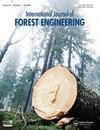Timber harvesting on fragile ground and impacts of uncertainties in the operational costs
IF 2.1
3区 农林科学
Q2 FORESTRY
引用次数: 2
Abstract
ABSTRACT Forested wetlands with high water tables are sensitive to disruption from harvesting yet support commercially desired tree species like northern white-cedar. Winter harvest was conducted in Maine, USA, to compare operational costs and productivity of cut-to-length harvesting in cedar (fragile soil) and non-cedar stands (mixedwood, sturdy soil), evaluate uncertainties in harvesting costs and influential factors, and forecast time for post-harvest recovery to pre-harvest volumes. Operational costs were calculated using detailed time and motion studies. Operational costs for the cedar stands were higher than non-cedar. Regression models were developed for harvesters, forwarders, and self-loading trucks; number of logs per cycle was a common factor. Sensitivity analysis showed the dependence of operational costs on labor and fuel costs. Forest Vegetation Simulator projections were used to assess harvest sustainability and suggested the time required to regrow harvested merchantable volume is comparable to cutting cycles recommended for similar treatments in the region. Predicted growth rates exceed those reported regionally on similar sites, suggesting additional study of post-harvest response is warranted. Results highlight site constraints on both operational and stand productivity in lowlands and will be useful for timber harvesting decision-making and forest management planning if combined with assessment of residual stand growth response.脆弱土地上的木材采伐及作业成本不确定性的影响
高地下水位的森林湿地对采伐造成的破坏很敏感,但却支持商业上需要的树种,如北方白雪松。在美国缅因州进行了冬季采伐,以比较雪松林(脆弱土壤)和非雪松林(混合木,坚固土壤)的作业成本和生产率,评估采伐成本和影响因素的不确定性,并预测采伐后恢复到采伐前体积的时间。操作成本是通过详细的时间和动作研究来计算的。杉木林的经营费用高于非杉木林。针对收割机、货代和自卸车开发了回归模型;每个周期的日志数是一个常见因素。敏感性分析显示操作成本对人工和燃料成本的依赖性。森林植被模拟器预测用于评估收获的可持续性,并建议重新种植收获的可销售量所需的时间与该地区类似处理建议的采伐周期相当。预测的增长率超过了在类似地点报告的区域增长率,这表明有必要对收获后的响应进行额外的研究。研究结果强调了低洼地区林分生产力和作业生产力的场地限制,如果结合剩余林分生长响应的评估,将有助于木材采伐决策和森林管理规划。
本文章由计算机程序翻译,如有差异,请以英文原文为准。
求助全文
约1分钟内获得全文
求助全文

 求助内容:
求助内容: 应助结果提醒方式:
应助结果提醒方式:


